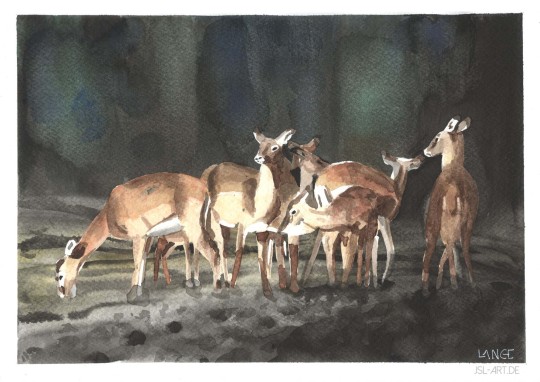#AnimalHerding
Explore tagged Tumblr posts
Text
#Izmir1911#renklitarih#izmirtarihi#oldvideos#eskiturkiye#1910sFashion#TurkishHistory#FarmingScenes#AnimalHerding#Beekeeping#StreetPerformers#HistoricalIzmir#NostalgicTurkey#VintageTurkey#TravelHistory
0 notes
Text

Watercolour Sketch of Antelopes
A friend says my paintings are all so dark - I don't think of them that way, I just need dramatic shadow-play. This bunch of antelopes in the zoo lives with marabous and giraffes. On my ref photo they looked like uncredited extras; I love the view of a hundred skinny legs of herds. It proved difficult to apply liquid frisket on already painted areas when I use water in the brush to keep it clean - naturally it will lift the paint. Tricky.
#watercolourart#aquarelle#traditionalpainting#a4artwork#originalart#zooanimal#artstudy#sketch#hagenbeck#zoohamburg#antelopes#gazelles#animalherd#baroqueart
1 note
·
View note
Text
18. EXCERPTS X: Crowds

Animal herds are formed by the reward of proximity and cemented by familiarity. They are therefore constrained to act in concert. This has been observed in the field in which individual baboons made tentative moves until the whole group achieved the momentum to move. This illustrates the way that individual initiative is extensively subsumed within the crowd. Usually, the movements of herds are governed by their need to have access to food as they amble across the landscape. However, they may be jolted by a perceived or real danger from predators, which causes them to stampede. Once in motion, they are constrained by the crowd to continue until they tire or the risk has abated. This herd instinct is manifested not only by animals but also strongly by humans. It is indeed an essential property of social organisms and can be expected to be greater for those species that have the highest degree of sociality, among which humans are a prime example. There are clear fitness advantages for members of species to work together towards a goal, and the reward of adhering to this convention is deeply embedded in the psyche of the individual. The herd instinct accounts in a fair measure for the willingness of individuals to abandon their careers in order to fight in wars. On the other hand, the herd instinct can lead initially to complacency in the perception of danger and subsequently to hysterical responses if the tenor of life changes. The nature of these sharp variations in behavior by humans is often complex and contains a mixture of rational and irrational components. There are many circumstances in which they undergo a transition from bland optimism to searing fear. A case in point was the housing bubble at the beginning of the twenty-first century, which was not associated with any technological advances but reflected an irrational loosening of the requisite standards for purchasing a house. The principal victims of the recession that followed were the general public, most of whom never engaged in the perversities that caused the crisis. Only a limited number of economists, financiers, businesspersons, or regulators predicted the outcome, despite a centuries-long history of fluctuations in business rationality. This irresponsibility is by no means confined to finance; whenever dogma and ideology interfere with rationality, a crisis may ensue. Nearly all people are content to continue their daily activities with little regard to impending crises until the opportunity to escape from the consequences has passed. The human example reiterates the point that animals are not genetically competent to maximize their fitness in a changing ecology in large part because they respond to immediate rewards and penalties and discount future effects. (p170) Climate change, anybody? Read the full article
#animalherds#comparisonbetweenmanandanimals#groupofpeople#herdinstinct#irrationalcomponantes#rationalcomponents
0 notes
Photo

Unicorn Herd
When the main unicorn's design was finished there was room in the composition for some more unicorns - I have this idea of an even larger herd, but one needs to start small with bigger projects. I got to use my favourite kind of horn again, although one of the typical slender whale-inspired horns is still missing in my collection. You can take these beauties home by visiting Etsy, https://www.etsy.com/listing/816728159/unicorn-herd-charcoal-drawing-of-a-herd
Charcoal and chalk on paper, 61×43cm.
#unicorn#animalherd#manyunicorns#fantasycreature#fairytale#blackandwhite#charcoal#drawing#onehorn#brothersgrimm#equineart#artonetsy#fantasyart#fantasyclassic#horse#pony#monoceros#traditionalmedia#chalk#riding
1 note
·
View note